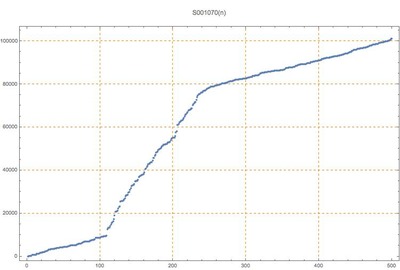Numbers n such that the digits of prime(1) to prime(n) concatenated in some order is possibly a palindrome.
1, 36, 247, 300, 306, 308, 640, 734, 735, 839, 848, 874, 1211, 1253, 1255, 1315, 1397, 1757, 1809, 1829, 1949, 1953, 2037, 2241, 2290, 2525, 2527, 2731, 3082, 3115, 3117, 3119, 3359, 3373, 3377, 3433, 3541, 3695, 3765, 3767, 3911, 3961, 4023, 4053, 4101
1
The digits of each prime are kept together. So for the first non-trivial case, the palindrome is the concatenation of 2, 3, 5, 7, 11, 13, 17, 19,…, prime(36) in some order. The center digit of the resulting palindrome must be a 9 because a count of the digits on the primes 2..151 is {4, 24, 4, 14, 4, 4, 2, 12, 2, 9}.
T. D. Noe, Plot of 500 terms
T. D. Noe, Table of 500 terms
Carlos Rivera, Puzzle 891: The first N integers arranged to form a palindrome
(Mma) t = {}; n = 0; While[Length[t] < 50, n++; d = IntegerDigits /@ Prime[Range[n]]; ds = Sort[Flatten[d]]; tds = Transpose[Tally[ds]][[2]]; If[OddQ[Length[ds]] && Count[tds, _?(OddQ[#] &)] == 1 || EvenQ[Length[ds]] && Count[tds, _?(OddQ[#] &)] == 0, AppendTo[t, n]]]; t
Cf. S001071.
nonn,base,hard
T. D. Noe, Sep 01 2017
